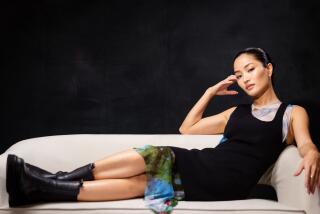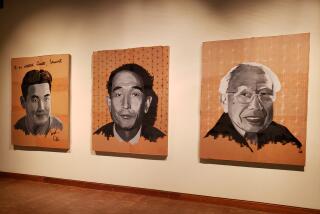MUSIC AND DANCE REVIEWS : KISANUKI AT JAPAN AMERICA THEATRE
- Share via
Kuniko Kisanuki belongs to the new generation of Japanese modern dancers exploring the frontiers of personal/experiential communication.
Billed as a “dance pilgrim” on posters for “Tefu Tefu,” her hour-long solo Saturday on the “Faces of Japan” series at the Japan America Theatre, Kisanuki indeed seemed on an arduous journey as she entered slowly along the left audience aisle and moved carefully, uncertainly, across the stage area.
Wearing a dress (by Riyoko Shinohara) as tattered as the canopy of curtains (by Seigo Yatagai) behind her, Kisanuki sometimes walked in a narrow line of light as if balancing on a tightrope--and elsewhere staggered, stretched and tumbled through passages in which a sense of equilibrium proved hard won and often was achieved in the most unorthodox alignments.
In the early sequences, the boldest contrasts in “Tefu Tefu” came not from Kisanuki’s dancing but rather from the intense shifts of Yoshiaki Kubo’s lighting design and the percussive eruptions of Bun Itakura’s sound score. Later, however, two quasidramatic episodes revealed her powerful emotional resources.
In the first, she struggled against a seemingly intractable body to walk: torso bent, legs twisted, hands gnarled. In the last, culminating section, she managed to dance in conventional terms: an ecstatic, childlike dance of reaching arms, buoyant feet and yet a deliberate awkwardness, as if intent on making this an ordinary person’s moment of affirmation, not a statement of idealized lyricism.
Kisanuki’s style incorporated elements of gymnastics, classical ballet and both the folk dancing and great ceremonial dance-theater idioms of her native Japan. But she seemed less interested in the formal fusion (or juxtaposition) of past and present, East and West, than the emotional resonances that such dichotomies set off in her.
Unlike equally personal yet more formally structured (indeed almost architectural) movement compositions by Kei Takei or Eiko and Koma, “Tefu Tefu” appeared to exist only as an externalization of Kisanuki’s impulses and feelings: her sensibility responding to her world. It represented dance at its most evanescent. Only improvisation offers a freer (and riskier) transference from mind to action, a deeper commitment to a mutable, individual truth.
More to Read
The biggest entertainment stories
Get our big stories about Hollywood, film, television, music, arts, culture and more right in your inbox as soon as they publish.
You may occasionally receive promotional content from the Los Angeles Times.










